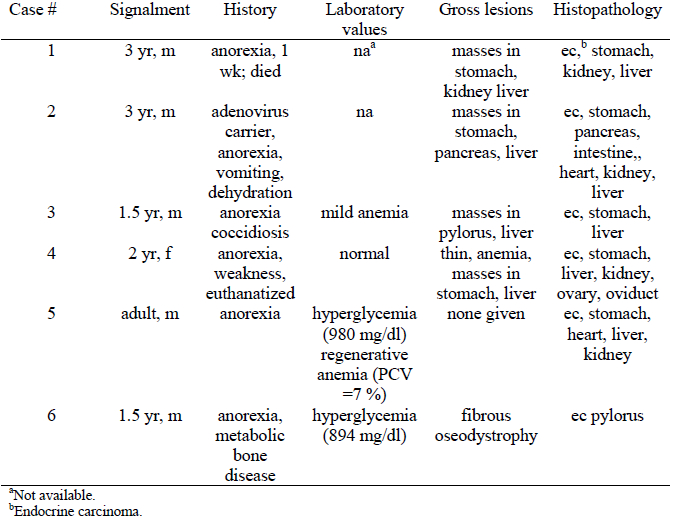Abstract
Bearded dragons are popular pets and exhibit animals. These lizards constituted approximately 3% of the reptile biopsy and necropsy submissions to Northwest ZooPath from 1994–2006.1,2 Some trends exist in bearded dragons regarding neoplasia and include peripheral nerve sheath tumors and myelocytic leukemia.1-4 This report describes an apparent emerging trend in the development of gastric endocrine carcinomas in this species, with a relative prevalence of this tumor of 1.5% at the primary author’s diagnostic service.
A review of the records at Northwest ZooPath and the Veterinary Medical Teaching Hospital at the University of Wisconsin identified 6 bearded dragons with these neoplasms. Table 1 summarizes signalment, history, abnormal blood values, and lesions. Five were male, 1 was female. Ages ranged from 1.5–3 y. All presented with anorexia. Two were anemic. Two had severe hyperglycemia. Gross lesions included nodular pale yellow to white masses up to 1 cm in diameter in the stomach or pylorus (4), and liver (4). Histologic examination revealed an endocrine carcinoma arising from the gastric or pyloric mucosa (6), with metastasis to liver (5), kidney (4), heart (2) and 1 each of pancreas, ovary, and oviduct. A Churukian Schenk stain applied to tumor of case 6 identified cytoplasmic argyrophilic granules in the neoplastic cells. Immunohistochemical staining for glucagon was negative for case 6. Electron microscopy identified spherical, dense-core granules typical of neuroendocrine granules in the cytoplasm of neoplastic cells in the tumor from Case 6.
Table 1. Signalment, history, laboratory values and lesions associated with gastric endocrine carcinomas in bearded dragons (Pogona vitticeps)

We conclude that young bearded dragons are predisposed to development of gastric neuroendocrine carcinoma, a high-grade malignancy that readily metastasizes. The cause for the predisposition to this otherwise unusual tumor is unknown. Because two affected lizards had marked hyperglycemia, it is considered possible that these tumors may in some cases be functional glucagonomas.
Literature Cited
1. Garner MM, Hernandez-Divers SM, Raymond JT. Reptile neoplasia: a retrospective study of case submissions to a specialty diagnostic service. Vet Clin Exot Anim. 2004;7:653–672.
2. Hernandez-Divers SM, Garner MM. Neoplasia of reptiles with an emphasis on lizards. Vet Clin Exot Anim. 2003;6:251–273.
3. Lemberger KY, Manharth A, Pessier AP. Multicentric benign peripheral nerve sheath tumors in two related bearded dragons, Pogona vitticeps. Vet Pathol. 2005;42:507–510.
4. Tocidlowski ME, McNamara PL, Wojcieszyn JW. Myelogenous leukemia in a bearded dragon (Acanthodraco vitticeps). J Zoo Wildl Med. 2001;32: 90–95.